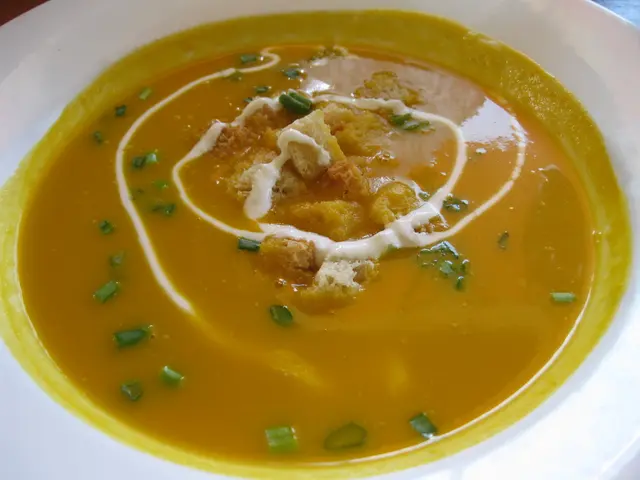Exploring Sattu as a Protein Powerhouse: Health Advantages, Culinary Uses, and Dietary Incorporation Strategies
In the world overwhelmed with protein powders and fancy supplements, a humble, traditional flour is standing tall - Sattu. Nicknamed "poor man's protein," this desi superfood isn't just popular in rural homes but is also making a comeback in urban kitchens, even gym diets. But, is Sattu a reliable protein source? Let's take a closer look at this timeless flour, its nutritional value, and ways to incorporate it into your daily meals.
What is Sattu?
Sattu is a flour created from roasted Bengal gram (chana), but variations can include barley, oats, or other pulses. This staple flour originates in Bihar, Jharkhand, Uttar Pradesh, and parts of Madhya Pradesh. It was traditionally consumed as a cooling drink during the hot summer months, but today, it's a versatile, nutrient-dense ingredient.
Protein Power
Yes! Sattu made from roasted Bengal gram is an excellent plant-based source of protein. In 100 grams, it offers about 20-25 grams of protein. It also contains essential amino acids, dietary fiber, iron, magnesium, and very little fat. Although it may not match the bioavailability of whey protein, it's an excellent choice for vegetarians, vegans, and those seeking whole food-based nutrition.
Health Benefits
Regularly consuming sattu comes with numerous perks:
- Improved Muscle Health: The high protein content makes it ideal for muscle repair and growth, especially for an active lifestyle.
- Fullness and Weight Loss: Its fiber and protein combined help suppress hunger and improve satiety, aiding in weight management.
- Natural Body Cooler: During sweltering summers, sattu sharbat works as an instant coolant, hydrating and replacing lost salts.
- Digestion Benefits: Roasted gram helps in regulating bowel movements and aids in smooth digestion.
- Diabetic-Friendly: With a low glycemic index, it assists in maintaining blood sugar levels when taken without added sugar.
Experience Sattu Your Way
Sattu is easy to work with and is flexible. Here are some popular and creative methods for enjoying it:
- Sattu Sharbat (Sweet or Salty): Make a refreshing, cooling drink by mixing sattu with chilled water, jaggery or honey, a pinch of cardamom (for the sweet version) or lemon juice, black salt, roasted cumin powder, and mint (for the savory version).
- Sattu Paratha (Stuffed Flatbread): Create a spicy filling using sattu, chopped onions, green chili, mustard oil, and pickle masala, and stuff this mixture into wheat dough before cooking like a regular paratha.
- Sattu Ladoo: Combine sattu with jaggery and ghee, shape into small balls, and enjoy a protein-rich, kid-friendly snack.
- Sattu Pancakes or Chilla: Prepare a savory pancake or chilla by mixing sattu with besan, onions, chilies, coriander, and cook like traditional pancakes or chillas.
- Sattu Smoothie: Blend sattu with banana, peanut butter, milk or plant-based milk, and a dash of cinnamon for a pre- or post-workout meal.
Sattu – Fitness Lovers' Friend
Enjoy Sattu for breakfast, pre-/post-workout, lunch, or dinner:
- Morning: Kickstart your day with sattu sharbat for a burst of energy and improved digestion.
- Pre/Post-Workout: Replace processed protein shakes with a Sattu smoothie.
- Evening Meal: Make sattu paratha or chilla for a hearty, high-protein meal that keeps you full.
- Daily Intake: A safe serving for most adults is 2-4 tablespoons. Consult a dietitian if you have kidney issues or specific dietary restrictions.
So, is Sattu Better Than Whey?
While both Sattu and whey protein offer impressive nutritional benefits, they cater to different dietary needs:
- Sattu: Ideal for vegetarians, vegans, and those seeking whole food-based nutrition with added fiber and minerals.
- Whey Protein: Most suitable for those requiring high bioavailability and essential amino acids for muscle growth and recovery.
So there you have it - a closer look at the humble but powerful superfood, Sattu. Whether you're a health enthusiast, a diabetic, a busy professional, or a curious foodie, Sattu fits perfectly into your lifestyle. Reap the benefits of its protein-rich, fiber-filled goodness, and give your diet a traditional, yet modern makeover!
Sattu, a flour made from roasted Bengal gram, offers about 20-25 grams of protein per 100 grams, making it an excellent plant-based source of this essential nutrient. This versatile ingredient, originating in Bihar, Jharkhand, Uttar Pradesh, and Madhya Pradesh, comes with numerous health benefits such as improved muscle health, aiding in weight management due to its fiber and protein, serving as a natural body cooler during hot summers, promoting digestion, and offering benefits for diabetic individuals with a low glycemic index.urban kitchens, even gym diets. Sattu is not only a source of protein but also contains essential amino acids, dietary fiber, iron, magnesium, and very little fat, making it an excellent choice for vegetarians, vegans, and those seeking whole food-based nutrition. With its nutrient-dense properties, it can be incorporated into various meals, such as Sattu Sharbat, Sattu Paratha, Sattu Ladoo, Sattu Pancakes or Chilla, and Sattu Smoothie. Whether you're a health enthusiast, a diabetic, a busy professional, or a curious foodie, Sattu fits perfectly into your lifestyle and offers a traditional, yet modern, makeover to your diet.








